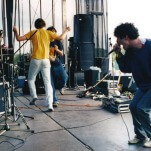Jazzfest 2015: Bobby Lounge, Alison Krauss, Irma Thomas & More
To understand the New Orleans Jazz & Heritage Festival, it helps to grasp the geography. The annual fest is held on the New Orleans Fairgrounds, the city’s racetrack. Within the turn at each end of the oval track is a huge grassy field with a big stage that hosts the most popular acts. Between these two big stages are four small stages and one medium stage that host the local Louisiana acts and more specialized genre acts. Within the racetrack grandstand are two more small stages and in the adjacent parking are the three large tents specializing in jazz, blues and gospel.
Because the big stages get so densely crowded, there’s a temptation to stake out a position up front in the morning and just stay there all day. And if you had never seen The Who, it might have made sense to camp out at the Acura Stage all day on April 25 to see Pete Townsend and Roger Daltrey one time before they die. But to do so, you would have missed out on such terrific Louisiana acts as Ellis Marsalis, Warren Storm, the Mahogany Brass Band, the New Orleans Klezmer Allstars, Joe Krown and the Lost Bayou Ramblers.
You have to ask yourself: Why you travel to an out-of-state festival? Is it to more efficiently see the same touring bands that come to your city? After all, a festival doesn’t require you to drive and park for each act; you can park once and see six or seven acts in a day. Or do you travel to a different region to soak up the local culture—not just the food and music, but also the local residents who make the food and music what it is? A Louisiana band plays differently in New Orleans than it does anywhere else, just as a Texas band plays differently in Austin. To hear Trombone Shorty or John Boutte play before a hometown crowd is to understand something about their music you would never get if you heard them in New York or L.A.
I prefer the latter approach. So when I attended Jazzfest, as it’s popularly called, I avoided the two big stages as much as possible to focus on the smaller stages in between. I wasn’t puritanical about it; I did see Trombone Shorty, Alison Krauss, Sturgill Simpson, Chris Stapleton, the Word and the Meters on the big stages, but I spent much more time at the Fais Do Do Stage tucked between the Gentilly Stage and the Congo Square stage. Named after the Cajun French phrase for “Go to sleep” that mothers murmured to their young children so the parents could start dancing, the stage was mostly devoted to Louisiana’s Cajun and zydeco acts.
The area in front of the stage is usually a green lawn, but on Thursday, April 30, it more closely resembled a beach, because truckloads of sand had been dumped there to cover the mud from the previous weekend’s torrential downpours. By the end of that day, the dancers had pounded that sand into a hard-packed dirt floor. And how could they resist dancing to such Cajun acts as Steve Riley and Kevin Naquin and the great Creole band led by African-American accordionist and Francophone Cedric Watson?
As the weekend wore on, the Fais Do Do Stage hosted the all-female Bonsoir Catin Cajun Band, Leroy Thomas & the Zydeco Roadrunners, and Major Handy & the Louisiana Blues Band. Three acts stood out in particular. Watson’s former band, the Pine Leaf Boys, has stretched the boundaries of their Cajun sound to include the country and rock-flavored swamp-pop sound of South Louisiana. When Wilson Savoy put down his button accordion to pound out Louisiana native Jerry Lee Lewis’s “Whole Lotta Shakin’ Goin’ On” and one-time New Orleans resident Ray Charles’s “Hallelujah, I Love Her So,” he made those local ties seem obvious.
-

-

-

-

-

- Curated Home Page Articles By Test Admin October 21, 2025 | 3:10pm
-

- Curated Home Page Articles By Test Admin October 21, 2025 | 2:57pm
- Urls By Test Admin October 21, 2025 | 2:57pm
- Curated Home Page Articles By Test Admin October 21, 2025 | 2:55pm
-

-

-

-

-

-

-

-

-

-

-

-

-

-

-

-

-

-

-

-

-

-

-

-

-

-

-

-

-

-




































